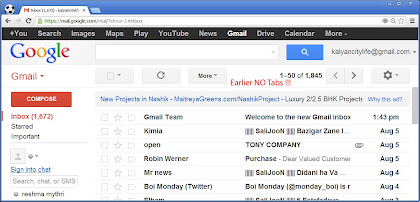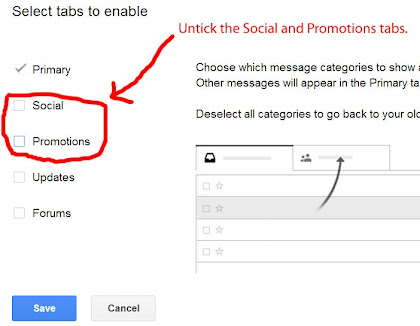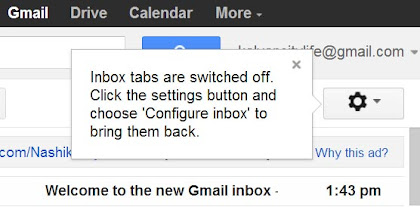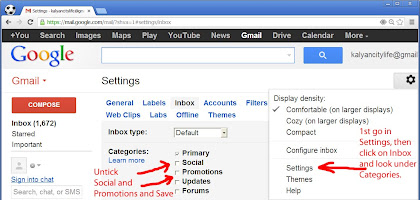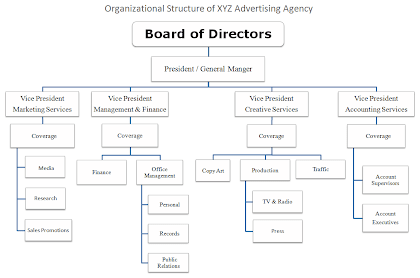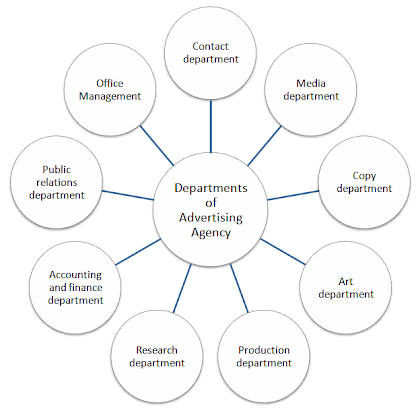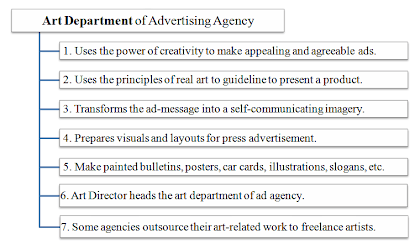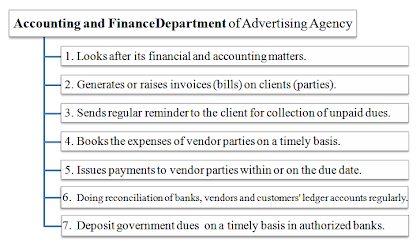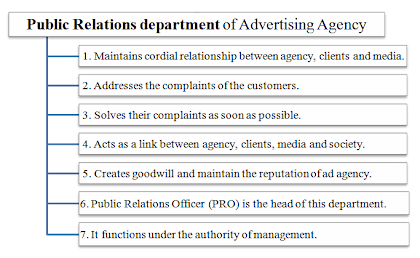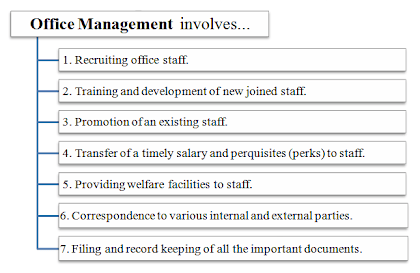Organizational structure of advertising agency
Advertising agency must have a suitable internal organizational structure to keep functioning properly with a smooth workflow.
When an advertising agency decides to establish its organizational structure, it must ask itself important questions like:
- What is the suitability and/or requirement of a department?
- How the span of control should be within an agency?
- Is there any mechanism or provision to make communication and coordination more effective within an agency? So on.
All advertising agencies don't have a same organizational structure. Their structure varies from one agency to another. It is so, since, all organizations are unique and their objectives, requirements, functional areas and specialized departments are not common.
Diagram, an example of organizational structure of advertising agency.
The organizational structure of an ad agency becomes more complex with its expansion and growth. Smaller agencies usually have a simple organization-structure compared to giant ones who have ample funds and resources to carry out their large and growing operations in the field of advertising.
Departments of advertising agency
The main functional departments of advertising agency:
- Contact department,
- Media department,
- Copy department,
- Art department,
- production department
- Research department,
- Accounting and finance department,
- Public relations department and
- Office management.
Now let's discuss these important functional departments of an advertising agency along with specialized-functions assigned to them.
1. Contact department
Contact department of advertising agency keeps contact with their prospective clients, who are mostly advertisers.
The functions of contact department are as follows:
- Contact department supplies necessary information to the clients.
- It tries to increase and retain the number of clients of agency.
- It brings new clients to the agency which is crucial for increasing revenue, expansion and growth.
- It acts as a liaison authority (connection) between the advertising agency and its clients.
- It acts as a sales promotion department of the ad agency.
- It finds out new clients and promotes the business of agency.
The contact department of ad agency comes under accounting services. Account Executive is the head of it.
Efficient working of this department results in quick growth of ad agency.
2. Media department
Media department of advertising agency selects the best-media for advertising the products of the clients.
While selecting a media for advertising it must consider the following:
- Nature of the product,
- Competition in the market,
- Advertising budget of the client,
- Media trends, etc.
The functions of media department are as follows:
- Select and use the best media possible to communicate the ad message to the consumers. This is very important function because a wrong selection will result in the failure of product.
- Prepare a media plan for clients.
- Media scheduling.
- Supervise the execution of the schedule.
- Buy or book an advertising time and space in media for client.
- Keep contact with various media.
Media department of ad agency comes under marketing services.
3. Copy department
The main function of a copy department of advertising agency is to prepare an attractive copy-of-ad.
The copy of advertisement is very crucial. It is called the Heart of the AD. It is so, since it directly communicates the ad-message to the consumers.
The staff of this department includes copywriters, copy-supervisors, and others. They use their talent of imagination, skill of putting flair and fluent language while preparing a copy.
The advertising will be a failure if the copy is not appealing to consumers. The copy-staff works in close co-operation with the staff of the art and visualization branch.
The head of copy department is a Copy Chief. He directs the functioning of it.
The copy branch is perhaps the largest department of ad agency. It comprises of a hard-working team of qualified professionals and experienced staff.
Some agencies have a creative branch instead of it that does the entire work of preparing an advertisement. Here, preparing an ad copy, artwork and actual production of ad are all linked together and executed completely by this department alone.
4. Art department
Art department of advertising agency uses the power of creativity and to make ad more appealing and agreeable. Its activity is not a mechanical one. It uses the principles of real art (that works) as a guideline or base to present a product to the targeted audience.
Generally, the art department carries out following work:
- Transform the ad-message into a self-communicating and mind-stimulating imagery.
- Prepare visuals and layouts for press advertisement.
- Make painted bulletins, posters, car cards, illustrations, slogans, etc.
Art Director heads this department of ad agency. He is assisted by an assistant-art director, artists, visualizers and layout men.
The artists of art department work together with copywriters to make the final copy of advertisement more attractive.
Both departments of art and copy operates under the overall guidance and supervision of vice-president of creative services.
Not all ad agencies have a separate art department. Some prefer to outsource their art-related work to freelance artists.
5. Production department
The copy of advertisement is finalized by artists and copywriters. It is then sent to the production department of an advertising agency for its further processing.
As the copy reaches this department, its proper mechanical production begins.
The main role of a production department is to process & produce a final ad.
This department's traditional work activities usually are as follows:
- Keep in contact with printing press, typographers, photo engravers, etc.
- Assemble the typographic design patterns, engraved photos, illustrations, copy, etc. and prepare the final advertisement.
- Show it to the client (advertiser) and get his approval for its release.
- Send it (after approval) to print media like magazines, newspapers, etc. for advertising.
With advancements in technology, the use of print media is gradually slowly down. The digital media is now an emerging trend. As a result, some production houses have started adapting to this change. Now their work also includes activities like:
- Keep in contact with digital artists, web designers, etc.
- Assemble the work of digital art and prepare a final digital-ad.
- Seek approval of it from an advertiser.
- Send it (after approval) to digital media like the Internet, e-magazines, web videos, etc. mainly for online advertising.
This department is headed by a production manager.
Production department of ad agency comes under creative services.
Not all ad agencies have a separate production department. Some prefer to outsource their production-related work to others.
6. Research department
The success of an advertising agency greatly depends on the success of the client's ad campaign. Today, achieving success is not an easier task. It is getting very difficult now-a-days because of rising market competition. With so many alternatives and choices at hand, already well-established goodwill and trust on older brands, it is now tougher to attract and convince consumers. However, against all odds hope still exists.
To stand out from the plethora of availability and make the client's products and/or services attractive, needs not only huge amount of tedious work but also some good amount of research to begin with.
One must remember that without knowing, What to do? How to do? When to do? And where to do? Nothing can be achieved. However, with right direction and approach, everything can be made possible.
Therefore, the importance of research department in advertising is rising.
The main function of research department of advertising agency is to:
- Carry out research and obtain the necessary information.
- Engage in a rigorous and critical analysis of the obtained information.
- Use the findings (results) in different ways to achieving objectives.
Generally, this department collects information about:
- Market,
- Market competition,
- Market trends,
- Products and/or services,
- Competitors,
- Consumer behavior,
- Media trends,
- New trends in advertising, so on.
Agency makes use of above information for executing a good ad campaign.
The team of a typical research department usually comprises of:
- Investigators,
- Field workers,
- Analysts,
- Marketing assistants,
- Statisticians,
- Librarian and the staff of library, etc.
This team works under the guidance and direction a Research Director, who is the head of research department.
Research department comes under marketing services of ad agency.
Although research activities are highly beneficial, they do consume an ample amount of time, money and resources. Generally, small ad agencies can't afford such resource-intense activities and therefore, prefer not to keep a separate research-branch. They either do research on a smaller scale or use the data obtained by others. On its contrary, large-agencies prefer to maintain their own research-subsidiaries and don't take the risk compromising with the quality and genuineness of the obtained data.
7. Accounting and finance department
The main duty of accounting and finance department of advertising agency is to look after its financial and accounting matters.
The work activity of this department is usually as follows:
- Generate or raise invoices (bills) on clients (parties).
- Send regular reminder to the client for collection of unpaid dues.
- Book the expenses of vendor parties on a timely basis.
- Issue payments to vendor parties within or on the due date.
- Doing reconciliation (compare) of banks, vendors and customers' ledger accounts regularly.
- Deposit government dues on a timely basis in authorized banks.
The main staff of this department usually comprises of:
- Chief financial officer (CFO),
- Accounts receivable manager,
- Accounts payable manager,
- Accounts supervisors and
- Accounts executives.
This staff works under the guidance and supervision of vice-president of accounting services. He is the head of this department.
8. Public relations department
The main responsibility of a public relations (PR) department is to maintain cordial relationship between advertising agency, clients and media.
Generally, the PR department carries out following work:
- Address the complaints of the customers.
- Solve their complaints as soon as possible.
- Be a link between ad-agency, clients, media and society.
- Create goodwill and maintain the reputation of ad agency.
Public Relations Officer (PRO) is the head of this department, and his subordinates assist him regularly to maintain a cordial environment.
The PR department functions under the authority of management.
9. Office Management
The definition of office management according to Mills and Standingford,
“The art of guiding the personnel of the office in the use of materials, methods, machines and equipment appropriate to their environment in order to achieve its specified purpose.”
Generally, office management involves following important activities:
- Recruit office staff.
- Training and development of new joined staff.
- Promotion of an existing staff.
- Transfer of a timely salary and perquisites (perks) to staff.
- Providing welfare facilities to staff.
- Correspondence to various internal and external parties.
- Filing and record keeping of all the important documents.
Office-management of advertising agency operates under its management services.


